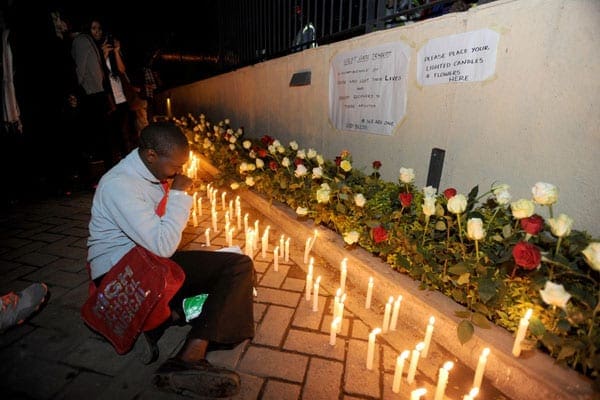
When the first shots of automatic gunfire burst out, Raju, a member of a local gun club, was waiting in line in a bank at the Westgate shopping mall. He crouched down, pulled out his phone and feverishly pecked out a text message: “I am inside and I can confirm this is not a robbery.”
Within minutes, his fellow gun club members, neighborhood watch volunteers, off-duty police officers and other armed Samaritans rushed to the mall. They found no command center, no SWAT team — in short, no coordinated government response as heavily armed Islamist militants shot civilians at will.
It was the beginning of a chaotic and what many Kenyans now call a bungled reaction by the national security services to one of the most chilling terrorist attacks this country has ever suffered, in which more than 60 men, women and children were killed.
Police officers and soldiers could not communicate with each other — their radios were on different frequencies, Kenyan officials said. Rescuers did not have blueprints for several hours, relying instead on printouts of rough floor plans from the Westgate Web site — that is, when it had not crashed as people around the world overloaded the site.
Some of Kenya’s best soldiers needed to be flown in from Somalia, and few, if any, of the forces at the mall had night-vision goggles, limiting night operations and giving militants time to regroup and possibly kill more people trapped inside, said several officials briefed on the response. Some victims may have been tortured, with bodies potentially mutilated, the officials said, suggesting the assailants had time on their hands.
“Somebody will have to answer us why it took the number of hours and minutes for the superior force to come in,” said Dalmas Otieno, a member of Parliament, this week.
There are still many mysteries. How many attackers were there? Did any escape in the confusion? Did they seize any hostages? How were they killed? And most of all: who were they and where did they come from?
On Tuesday, American officials said they were close to discovering the identities of the assailants from tests performed on their remains, and that they appeared to come from several different countries. For some of the attackers, all that was left were body parts. Another person briefed on the response said that Kenyan forces had fired a wire-guided antitank missile at the end of the counterassault, which sent a supermarket up in flames and caused an avalanche of bricks that may have buried the bodies of some attackers.
American officials worry this attack could be a harbinger of more strikes by the Shabab, the Somali militant group that claimed responsibility and has vowed to continue attacking Kenya and foreigners. The F.B.I. has sent dozens of agents to Kenya in the past week, but already the crime scene appears to have been compromised, with shops looted, cash registers emptied and windows smashed.
President Uhuru Kenyatta, who was initially praised by Kenyans for his leadership in this crisis, has watched his security chiefs come under withering criticism for failing to prevent the attack and then mounting a messy rescue effort. On Tuesday, he said his government would establish a commission to “see where there were lapses.”
There was no shortage of valor or self-sacrifice that day at the mall. The gun club members and off-duty officers helped rescue hundreds of terrified shoppers. One police officer was shot in the stomach and dragged to safety by a photographer.
But those moments “could eventually be overshadowed by revelations of infighting, a bungled rescue and numbers that don’t add up,” a columnist wrote in The Daily Nation, the biggest Kenyan newspaper, on Tuesday. Above the column, a sardonic cartoon showed soldiers making off with bulging bags of loot, dead people sprawled all around.
It was about noon on Sept. 21 when the attackers blasted their way into the mall. Western officials now believe that they may have been a small group, 4 to 8 people, not the 10 to 15 that the Kenyan government has claimed. Witnesses said some of the attackers used G3 assault rifles, like the Kenyan security services, and ammunition that included tracer bullets, a sign they may have acquired — or stolen — the weapons from the military.
The militants divided into at least two teams, officials said. One team raced up to the roof deck parking lot, where a cooking competition was being held. According to witnesses, the attackers threw a grenade and fired into the crowd, killing an estimated 25 men, women and children. One survivor, Aleem Manji, told a Kenyan television station: “They just opened fire, completely and absolutely.”
Downstairs, another team of assailants shot to death several people in the Urban Gourmet Burgers restaurant. The militants then sprayed gunfire into the air. Analysts said that might have been part of a tactic to terrorize people into submission so they could sort them into Muslims and non-Muslims.
The killers then strolled through stores and cafes quizzing potential victims on Muslim prayers, coldly executing those who did not know the answers. One man said he huddled in the back of a bookshop rocking his nine-year old son on his lap, the boy shuddering at every gunshot. The father said he gave up hope when the shopkeeper handed him a phone and told him to memorize a text message of a Muslim prayer. “We knew if they came, that was it,” he said.
Abdul Haji, a local businessman, drove “like crazy, even on the wrong side of the road,” to get to the Westgate mall, where his brother had texted him to say he was hiding in a bathroom. The son of a former Kenyan defense minister, Mr. Haji had a licensed Ceska handgun and a full clip of ammunition.
The first people Mr. Haji saw when he arrived were volunteer members of a neighborhood watch patrol, equipped with walkie-talkies, bulletproof vests and handguns. Some had received the text message from Raju, the member who was afraid for his safety to have his full name published. Plainclothes police officers, some off duty, also responded. They all plunged in behind Abbas Gullet, the head of the Kenya Red Cross, who was desperate to get the wounded out.
Witnesses described chaotic moments when the first rescuers entered the building. Joshua Hakim had just bluffed his way past the militants, pretending to be a Muslim, when an older foreign man frantically waved him over, asking if he could handle a spare firearm. “I had never shot a gun,” Mr. Hakim said, “so I just kept running.”
With a growing posse of armed responders flocking to the mall, several of the assailants dashed into the large Nakumatt supermarket, exchanging fire with some of the volunteers and police officers, wounding one. It was unclear if any shoppers were still trapped in the store.
By about 4 p.m., a special reconnaissance unit of the paramilitary police arrived. Soldiers from the nearby Langata barracks followed; elite forces had to be airlifted in from other areas of Kenya — and even from Somalia, where they have been trying to oust the Shabab — and didn’t arrive until hours later.
But Kenyan officials wanted even more help. Dozens of Israeli commandos and specialized police officers, with body armor and weapons, flew in from Israel, though they did not arrive until Sunday, said one of the people briefed on the details of the response.
Many witnesses have said that some of the assailants escaped, and even hours after the attack, the mall’s perimeter was not secured. James Quest, a local photographer, said that he just walked up the ramp from the parking lot around 4:30 p.m.
Mr. Quest said two soldiers were looking confused and had no idea how to locate the rest of their team. “They really needed help,” said Mr. Quest, who guided them into the mall. There was a haze of smoke still lingering in the air. He passed purses and cellphones still lying on tables, next to plates of uneaten food.
“The lights were on,” said Mr. Quest. “The music was playing.” He helped evacuate a wounded employee from the Nakumatt supermarket, his blue work smock soaked in blood, only to learn later that the man died from loss of blood.
Mr. Quest said he left the mall around midnight. He was outside the building when all the lights suddenly went out.
A person briefed on the attack said that the assailants had somehow seized control of the electricity and cut the lights. But it would not be until Sunday night or early Monday that Americans delivered night-vision goggles to the Kenyan forces.
Source-nytimes.com
What really happened at Westgate – From New York Times









